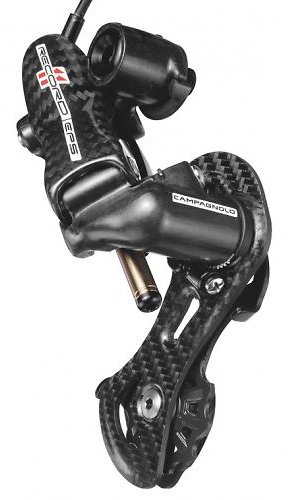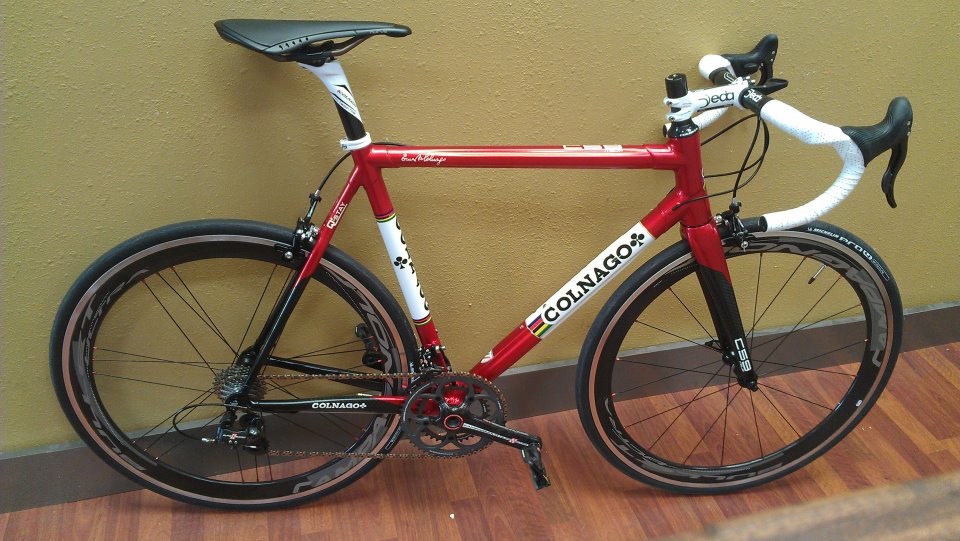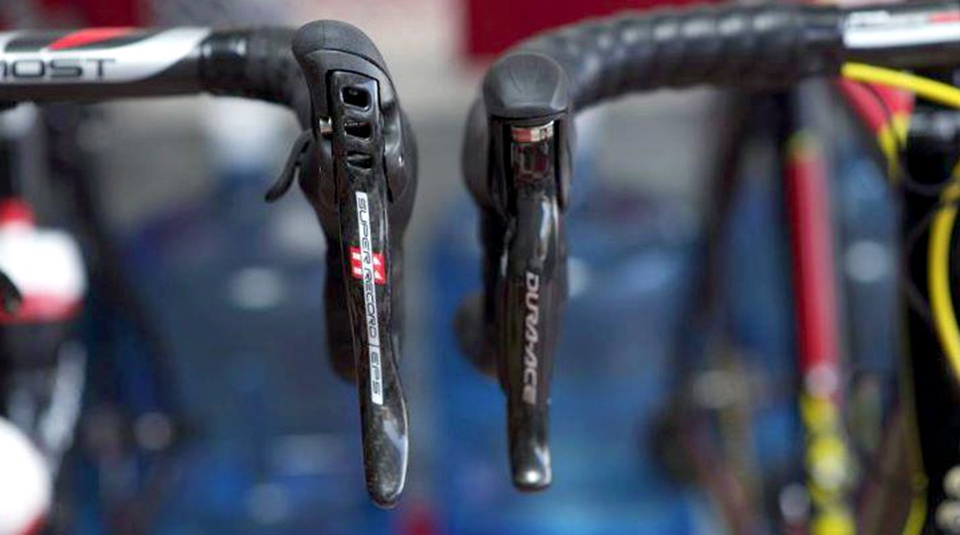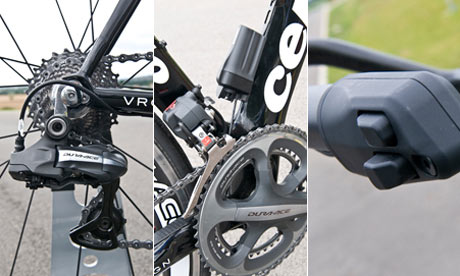The Electronic Revolution
When I first envisioned East West Bikes authoring a blog, I wanted it to be fresh and fun to read.
Creating just another place to read the same stuff that could be found elsewhere seemed boring and an obvious attempt at cheap web optimizing. For better or worse that goal established a tough standard to meet, but I see it as a fun challenge.
Its been two months since the Interbike Trade Show and I really wanted to come back and put up pics and content regarding all the new goodies that the industry showcased for the 2013 season. By the time I returned to SoCal and dusted off the Las Vegas madness, the web was already full with reviews and information.
But I still want to address the ever streaming topic of the electronic revolution (maybe better stated as Evolution). While our readers probably already know this, I will state it regardless, Banning and I do not and do not plan to sell electric bikes. I think we both would rather sell patio furniture out of a strip mall in Victorville than turn our shop into that. So of course I’m referring to electric drivetrains.
Historically, shifting systems on bicycles were rather simple. A shifter pulled a mechanic cable that was attached to a derailleur, which moved said derailleur a specific amount pushing or released the chain up and down the cog set. Sure, friction evolved to indexed, and down tube shifters evolved to integrated controls with the brakes (both ErgoPower and STI). About twenty to twenty-five years ago, both Campagnolo and Shimano started to develop electronic shifting systems, replacing those mechanical cable systems with electronic pulses emanating from the shifters to the derailleurs using wires in place of cables. After many years of development and testing at the Pro Tour level, Shimano debuted their system four years ago, dubbed Di2, on the Dura Ace level known as 7970. As soon as Di2 7970 was released, no one doubted that electronic shifting was far superior to mechanical in terms of speed, precision, reliability, and consistency. There was some initial drag on sales, however, due to the costs of the system. Last year, Shimano’s platform was improved a bit (in terms of wiring / adaptability for all possible applications known as eTube) as they introduced their second tier system in Ultegra 6770. That was the moment when the cycling industry and the general public announced there was no going back for most of the high end buyers.
“That was the moment when the cycling industry and the general public announced there was no going back for most of the high end buyers.”
Ultegra 6770 was essentially the same price as Dura Ace mechanical (7900) but had all the functionality of Di2. Campagnolo released their electronic systems, dubbed Electronic Powered System (“EPS”) in mid 2012, in both Record and Super Record versions, thus joining the electronic revolution. Admittedly, the EPS systems are both very expensive and perhaps not nearly as approachable as 6770 for the average consumer, however, there will be a much more affordable version in 2013 via the Athena platform. Just like Di2, EPS is better than mechanical in terms of speed, precision, reliability, and consistency.
Those who know me know that I’ve never doubted the benefits of electronic shifting systems, but I was late in joining the party. I poked fun a little as I believed and still do that the latest mechanical systems performed incredible well and the price of the systems (until the debut of Ultegra) seemed hard to justify given the quality of mechanical. But I finally did join the party a few weeks ago and I couldn’t be happier about my new system. I have a Super Record EPS groupset on a brand new Pinarello Dogma 65.1 Think 2 frame. Unlike most of my public writing, this blog entry will not continue as a Campy Only type diatribe of why one of the component makers trumps the other. Just the opposite. Both brands have systems that are amazing. They both set up and adjust with incredible ease and speed. Both have functionality that is without doubt better than mechanical shifting. Electric is faster and never misses. And yes, bears a “cool” factor like no other product since the intro of deep section full carbon wheels (remember the first set of Boras you saw, wholy crap that was sexy) and the STI / ErgoPower controls
Let's dispel a few myths
First, electronic drivetrains do not spell the end of your trusty mechanic. These systems do require skill to set up and adjust, but more importantly, the experience of doing it over and over. Further, brake systems (especially as things keep moving forward on disc), wheel building, bearing overhauls (headset, bottom bracket, hubs, etc), frame preparation, and general diagnosis of issues (dude, its making a clicking sound and I can’t figure it out) all will require the experience of a good and skilled mechanic. The second myth that always comes up is battery life. Both systems have batteries that last a ridiculously long time. Generally speaking, thousands of miles, with plenty of warning signs when the battery does need a charge. You will not need to bring your charger on that two week trip to Tuscany. Another common myth that I hear quite a bit is that the systems will short out in a rain storm. Couldn’t be more incorrect. These systems, through years of testing and design, are incredibly water proof. Regardless of where you live and how brave you are, no rain storm will ruin your ride or your bike. Last week, I got caught out in a pretty serious storm and I was so happily surprised at how well the system performed. There was really no degredation in shifting performance, regardless of how wet the bike became.
The next myth is hard to dispel, but I shall certainly try
“I just don’t need it. I’m not a pro, so why?” Need and want are very different words in the bike shop. Very few people ever reach the level of need for most products. Most of those who need are sponsored and don’t need to buy. But wanting something is not inherently bad or something to be ashamed or embarrassed of. Most people who own racing level cars don’t ever race them or compete in any way. Wanting something that’s stiffer / lighter / better is ok. For some, having the high end product helps motivate them to ride. For some, the eye candy in the garage (or bedroom if you’re a real nerd) makes coming home from the job easier. Electronic shifting is awesome. Don’t worry about need if you want it.
And finally the myth that seems almost more common than all others…
Mechanical groupsets will be extinct at some point relatively soon (5-10 years) on the high end levels. This one is probably more a matter of opinion at this point except for the select few in the industry that attend OEM events like the Taipai show. My own personal opinion is that mechanical will survive and there will always be a place for in the industry. Firstly, there are some frames that may never really adapt to the needs of the electric group sets (especially EPS which was really designed as a internally routed only system). Specifically, small steel artists / builders. Our shop favorite, Dario Pegoretti, has taken that position to date, as he does not want to drill holes in his frames to accommodate the internal routing. Sure he might change his mind some day, but anyone who wants a Peg in the next couple of years will be using mechanical or running their electronic wires externally (really not very clean looking with wires hard to conceal). Second, some riders actually prefer mechanical, and their opinion is as valid as mine or anyone else’s. Quite candidly, while I love my new EPS, I still love mechanical Super Record / Record / Chous and I could easily see putting my mechanical Super Record group set back on a bike and using it without feeling second rate. When I moved from ten speed to eleven, I assumed I would always prefer ten. One week later, I was over ten. I had fond memories of that “era,” but technically, I knew that eleven trumped ten all around. I don’t believe that to be the case when comparing the modern mechanical to the electric. Lastly, the component makers continue to move forward with their mechanical R&D, which is most evident with the upcoming release of Shimano’s new generation of Dura Ace mechanical, known as 9000 series. I’ve had the pleasure of riding a bike built with 9000 and I can report that it is absolutely amazing and a big step past 7900, which was already a wonderfully functioning system.
Notably absent from this discussion so far is the third component manufacturer, sram.
To date, not only have they not released an electronic shifting system, but most intelligence reports indicate they aren’t event close to bringing something to market. As a self admitted bike nerd who follows industry intelligence pretty close, I’ve seen nothing about their electronic R&D. They do seem to be as far forward on the road hydraulic disc front as anyone else. In fact, this week, many photos have surfaced of pros and amateurs riding their new Red (flagship level group set) hydraulic disc shifters, which seem really close to release – I’m guessing Sea Otter 2013 as the official launch. Even the decalling is ready to go based on the spy pictures. I surmise when I state that being the new player is probably catching up to them a bit on the electronic front, given that Shimano and Campagnolo have been doing electronic R&D before SRAM was even was in the mountain market, let alone their subsequent entry into road. Are their engineers busy getting the electronic research to hit the market in the next couple of years? Perhaps, and I certainly would never rule them out of it. Not their style to get passed by. But I would guess it would require incredible resources coupled with personnel recruiting efforts that would be monumental to catch up with the years put in by the other two companies. Only time will tell how it plays out.
Looking Forward
As mentioned earlier, Campagnolo is just about to officially release their Athena EPS system to hit a better and more approachable price point for the average consumer. While pricing is not fully known at the moment, it is expected to be similar to Di2 Ultegra 6770. Fully disclosed to the public at Interbike 2012. It will have the same functionality of its siblings but will have a weight penalty due to less exotic materials. That said, it is my opinion that they will need to also find a way to bring down the price of both Record and Super Record EPS . While those system are great, the price is still a bit hard to manage, even for the die hard Campag fan. It is also my opinion that they need to advance their wiring technology to give their system more flexibility for non traditional frames and for a better external set up option. I also feel as though Super Record and Record EPS should be compatible with Athena EPS, which currently is not the case (for instance, one can not combine a Super Record EPS shifter with an Athena EPS derailleur). All the Campy mechanical group sets (currently numbering four for eleven speed and two for ten speed) continue to be manufactured, promoted and sold.
Shimano is about to officially release Dura Ace Di2 9070, which provides several significant updates over Di2 7970. Most importantly, utilizing the eTube wiring setup, as found on Ultegra Di2 6770. It will also offer internal battery options, a common aesthetic complaint of the current Di2 system. Dura Ace 9070 will be fully compatible with Ultegra 6770, which is a brilliant move. Including but not limited to the main components as well as the optional accessories like the climbing and sprinting switches as well the TT and Tri shifting setups. Dura Ace 9000 mechanical is already available and will provide those who still prefer mechanical an incredible option. Shimano continues to manufacture and promote their other mechanical systems (numbering 3 for performance level).
SRAM will be first in the market with an official hydraulic disc shifter and provide their users the ability not to have to go with a shifter manufacturer alternative such as the Hope (conversion kit) or Forumula (alternative shifters for both Shimano and Campy). No electric on the immediate horizon. SRAM currently manufacturers and promotes four performance level mechanical systems.
Campagnolo EPS Athena 11
My crystal ball
Ten years from now, most racers and enthusiasts will have an electronic group set on their performance level bike.
Each manufacturer will offer three to four levels of options (such as Dura Ace / Ultegra / 105, or Super Record, Record, Chorus, Athena, etc.) for electronic. That said, each will still offer one, possible two, mechanical options (such as Dura Ace only or Record only). And yes, for SRAM to remain competitive, they will have electronic shifting systems. While not mentioned yet at all, mountain systems for all three component manufacturers will also be electronic sooner rather than later (we currently are able to use Di2 with very slight modification on mountain applications). Electronics will also be used elsewhere on the bike. Certainly on mountain suspension (forks, rear shocks, and dropper seat posts) in terms of lockout and travel adjustment. And maybe on both road and mountain braking systems.
For those of you who already have Di2 or EPS, smart move. That said, don’t complete discount mechanical. Stop by and try 9000, as I’m sure we’ll have a bike or three soon at the shop. For those who have not converted yet to Di2 or EPS, fret not as mechanical is far from lame. That said, don’t be the crabby person who refuses to acknowledge the present and future. Stop by and try both Di2 and EPS, even if you have no plans on purchasing anything soon, as its fun and costs nothing to ride my own personal bike (or Banning’s) around the block ten times. It's a fun way to kill time during your lunch hour.
As always, your friend,
Eric





